Home > Fireplace Blog > Gas Fireplaces: The Ultimate Guide
Understanding Gas Fireplaces
A gas fireplace is often considered the centerpiece of a home. It provides warmth, ambiance, and a gathering place for families during the cold winter months. Due to their efficiency, aesthetic versatility, and ease of use, they have emerged as a popular alternative to traditional fireplaces.
But what exactly is a gas fireplace, and how does it function? Below, we delve into the basic principles of gas fireplaces and the advantages they offer.

How Does A Gas Fireplace Work?
The functionality of a gas fireplace can be summarized as follows:
- They run on clean-burning natural gas or propane, not wood.
- They connect to your home’s gas line or a propane tank.
- Lighting them initiates a flow of gas to a burner, sparking flames that heat the space and resemble a traditional fireplace.
Convenience and Appearance
The standout feature? Absolute convenience. There's no need to chop, store, or carry wood, and there's zero ash to clean up afterward.
Furthermore, gas fireplaces feature ceramic or metal logs. While these logs don't burn, they heat up, giving the authentic appearance of glowing, burning logs. These units often come equipped with a variety of control options, including:
- Simple switch-operated ignitions.
- Remote controls that adjust the flame's height, heat output, and even the color of the flames in some advanced models.
What are the Benefits of Owning a Gas Fireplace?

Efficiency At Its Best
Gas fireplaces are highly efficient heaters. They provide more consistent and controllable heat output than any other fireplaces and ensure less heat is lost through the venting system. Some models are so efficient they can serve as a home's primary heat source on chilly days, reducing overall heating costs.
Aesthetics
Modern gas fireplaces come in an array of styles, sizes, and finishes to complement any home decor. From traditional looks that mimic a classic wood-burning fireplace to contemporary designs with sleek lines and glass media instead of logs, there's a gas fireplace to suit every aesthetic preference. The flames produced are incredibly realistic, and some units even allow customization of flame color and height.
Convenience
One of the most significant advantages of a gas fireplace is its ease of use. With the push of a button, you can ignite the flames and enjoy instant warmth. There's no need to build a fire, and you won't have to wait for it to catch and grow. Additionally, gas fireplaces require less maintenance than their wood-burning counterparts; there's no ash to clean, no creosote buildup to worry about, and no logs to split or stack.
Clean Burning
Gas fireplaces produce fewer emissions compared to wood-burning units, making them an environmentally friendlier option. They don't release smoke or particulates into the air, contributing to better indoor air quality and less pollution overall.
Safety
While all fireplaces require adherence to safety protocols, gas fireplaces eliminate some common hazards associated with wood-burning fireplaces, such as flying sparks or rolling logs.
Versatility
Since they don't require a traditional chimney and flue, gas fireplaces offer more flexibility in installation. They can be installed in almost any room of the home, providing you with the freedom to enjoy a cozy fire wherever you desire.
Types of Gas Fireplaces
When it comes to elevating your home with the warmth and ambiance of a gas fireplace, There are many selections of fireplaces to choose from and choosing the right type of fireplace is important. Each model has its own requirements and understanding them is key to selecting the right one that will fit your space and lifestyle.
Direct-Vent Gas Fireplace
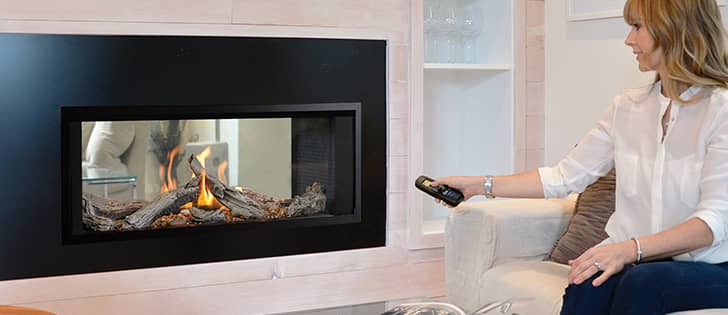
Direct-vent fireplaces are known for their safety and efficiency. They take air from outside for combustion and then remove the exhaust back outside. This process keeps the indoor air cleaner and prevents heat loss through the chimney. These types of fireplaces can be placed almost anywhere as they do not require an existing chimney. They use a special double-walled pipe: one for drawing in outdoor air and the other for removing gases.
Gas Fireplace Insert
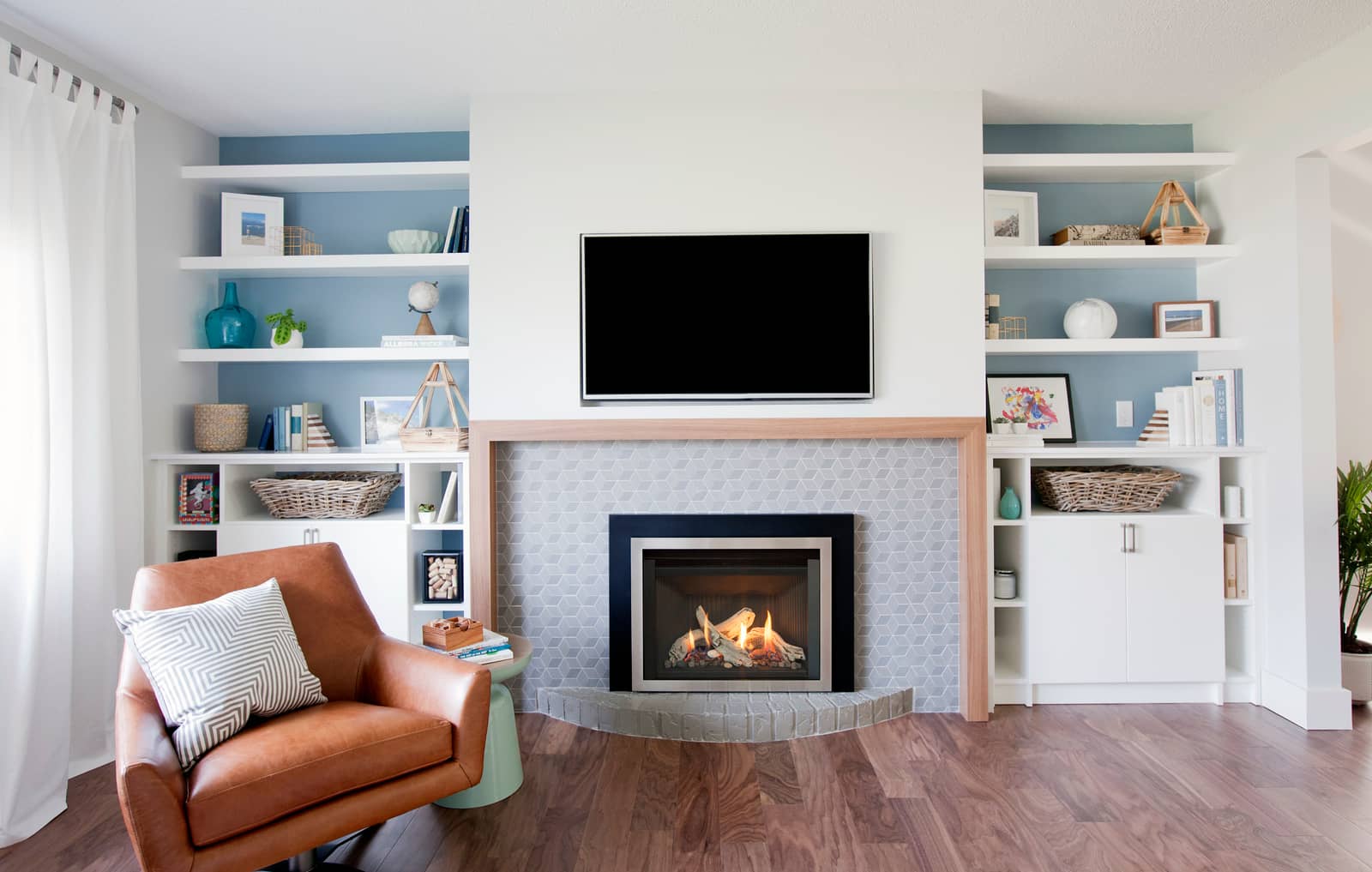
For those with existing traditional wood-burning fireplaces, gas fireplace inserts present an efficient solution. These inserts are designed to fit within the firebox of the current fireplace, converting it into a gas-burning unit. This option allows homeowners to retain the look of their traditional fireplace while benefiting from the convenience and efficiency of gas.
B-Vent/Natural Vent Gas Fireplace
B-vent fireplaces, also known as natural vent fireplaces, utilize an existing chimney or a B-vent pipe to expel combustion gases. They draw the air needed for combustion from inside the home and rely on the natural buoyancy of hot gases to vent effectively. While they're not as efficient as direct-vent models due to the indoor air being used for combustion, B-vent fireplaces are valued for their traditional aesthetic and the fact that they can be installed using existing chimney systems.
Vent-Free Gas Fireplace

Ventless or vent-free fireplaces don't require any chimney or external venting, which allows for installation in locations where vented fireplaces can't go. They're designed to burn very efficiently, ensuring complete combustion and producing minimal exhaust. This means they can operate using the room's oxygen without causing any buildup of harmful gases. However, they're subject to strict regulations due to concerns over indoor air quality, and they're not permitted in all areas. It's essential to check local regulations before considering a vent-free system.
Outdoor Gas Fireplace
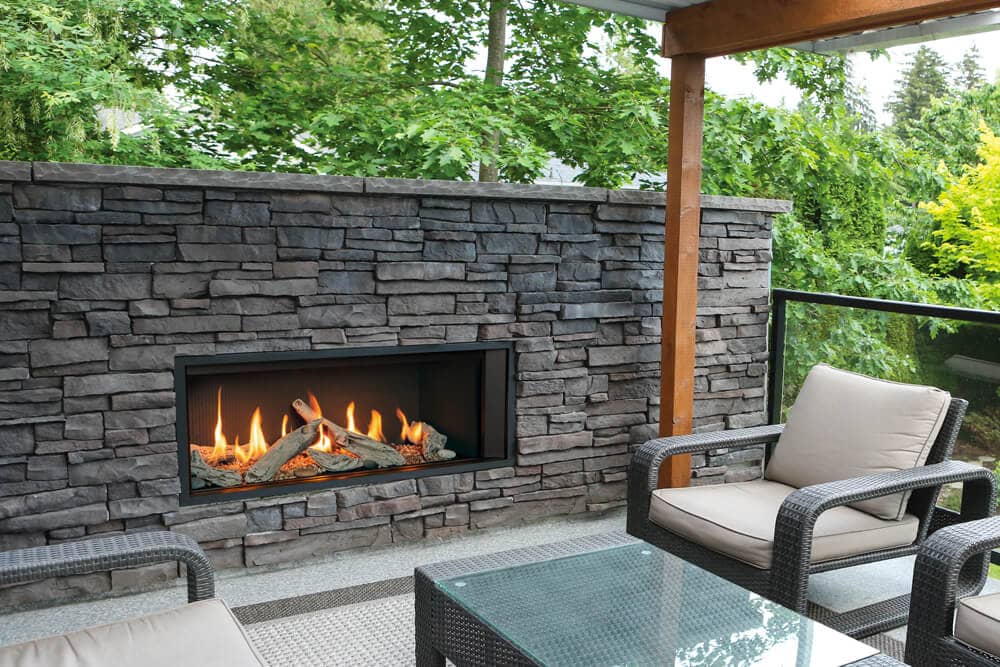
Outdoor gas fireplaces extend the comfort of your living space to your patio, deck, or backyard. They provide the ambiance of a traditional outdoor fire without the hassle of chopping wood or cleaning up ashes. These can be standalone structures or built into a wall, and they come in a variety of styles to complement your outdoor decor.
Choosing the Right Accessories For Your Gas Fireplace

Selecting a gas fireplace for your home involves more than just choosing a model that fits your space and budget. It's crucial to pay attention to the various accessories that make up your fireplace. These options not only contribute to the functionality and efficiency of your unit but also play a significant role in the overall aesthetic and ambiance of the space where you place your fireplace.
The Heart Of The Matter: Choosing the Right Gas Logs or Media Sets
At the heart of every gas fireplace are the log, rock, glass, or coal sets. These are not your ordinary fireplace media sets, but intricately designed ceramic or refractory cement pieces that mimic the look of real-world materials. They are the stars of the show, glowing red at the touch of the flames and providing the authentic, cozy feel that makes a fireplace so appealing. However, not all logs are created equal. They come in various sizes, shapes, and wood types, from birch to traditional logs, each designed to recreate the charm of a wood-burning fireplace without the hassle. The right fireplace gas logs and media set can transform your gas fireplace experience, so it's important to know how to choose a gas log style and size that complements your gas fireplace unit and room decor.
Other Key Components
Beyond the media sets, other components are vital to the operation, aesthetic, and experience of your gas fireplace.
- The burner is the engine of your fireplace, where the gas combusts and creates the flames. Different burners offer various flame patterns and intensities, so it's important to choose one that meets your heat requirement and aesthetic preference.
- The ignition system is another critical component. Some fireplaces feature a simple pilot light, while others use electronic ignition for more efficient operation. And let's not forget about safety features like oxygen depletion sensors (for vent-free units) and carbon monoxide detectors, which are crucial for safe operation.
- Various fronts and backing places make up the outward aesthetic of your gas fireplace. Choose between a variety of colored fronts to suit your home design, or install a backing plate to cover off a wall opening.
Maintenance and Longevity of a Gas Fireplace
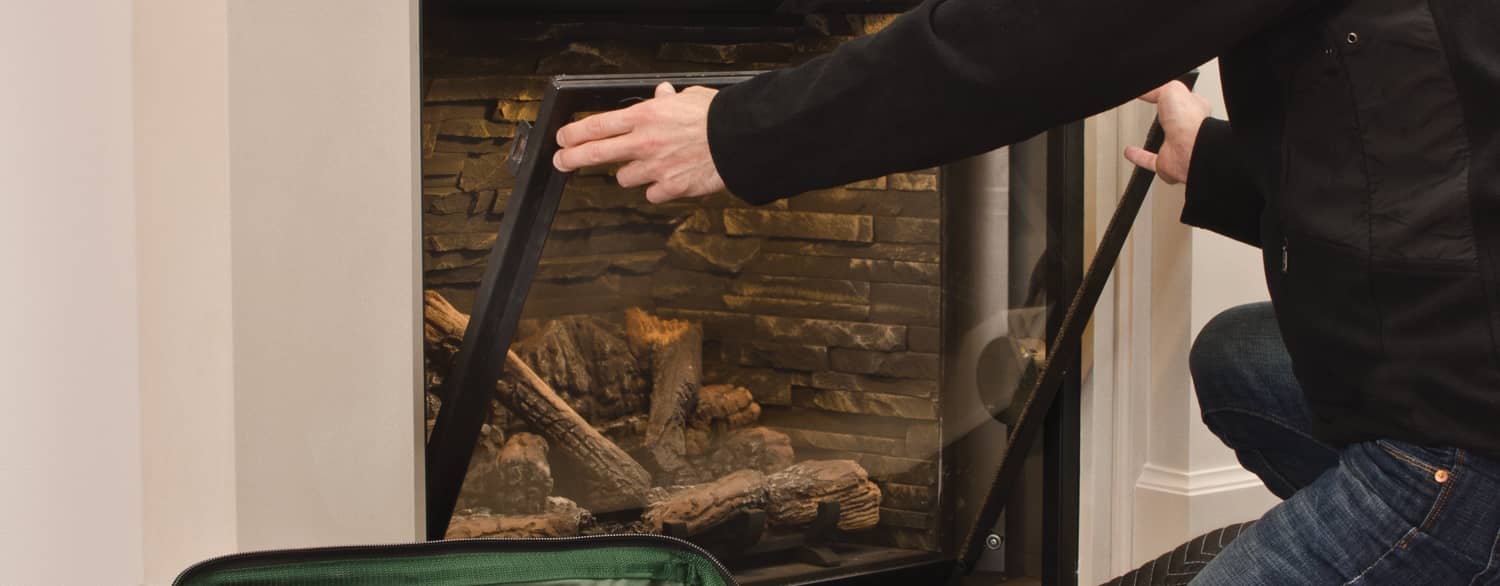
Gas fireplaces are not entirely maintenance-free. Regular maintenance is crucial to ensure your gas fireplace operates safely and efficiently for years. Proper care can prevent common issues such as blockages in the gas lines or ventilation system, malfunctioning ignition systems, and inefficient heating. Also, routine inspections can help detect potential problems early, avoiding costly repairs down the line.
Routine Inspections and Cleanings
Routine inspection and cleaning are recommended at least once a year by a certified professional. They will check the gas lines, test the ignition system, inspect the venting system, and assess all other components for wear and tear. Cleaning is also essential. Although gas fireplaces don't produce ash or soot like wood-burning fireplaces, they can accumulate dust and pet hair, and the glass doors can develop a cloudy residue. Regular cleaning ensures your fireplace continues to operate efficiently and looks its best.
Ventilation System
Maintaining a clear and functional ventilation system is paramount. Over time, vents can become blocked by debris or even nests from small animals, affecting the air quality in your home and the efficiency of your fireplace. Regular checks ensure the venting system is clear and functioning correctly.
Keeping the Gas Components in Check
The gas components, particularly the gas lines and ignition system, are vital to the safe operation of your fireplace. A professional can check for leaks in the gas lines and ensure the ignition system is working correctly, providing peace of mind that your fireplace is safe to use.
User Maintenance Of A Gas Fireplace
Regularly cleaning the glass doors, removing any debris from the vents, and testing the carbon monoxide detectors in your home are all simple but effective maintenance tasks that you can perform.
Read our detailed guide to gas fireplace maintenance to understand everything you can do to keep your gas fireplace in good condition
Comparing Gas and Electric Fireplaces
.jpg)
Both gas and electric fireplaces are popular options when it comes to adding warmth and ambiance to your home. However, they offer distinct experiences and benefits, depending on your home's setup, your budget, and your personal preferences. In this section, we'll compare gas and electric fireplaces in terms of cost, maintenance, ambiance, and installation to help you make an informed decision. if you would like to know more about the differences between gas and electric fireplaces, read our comparison guide
Cost
- Gas Fireplaces: The initial cost of a gas fireplace can be higher due to the need for venting and potential gas line installation. However, gas fireplaces can be more cost-effective in the long run, especially if you have access to a natural gas line, as they often produce more heat than electric models.
- Electric Fireplaces: Generally, electric fireplaces are less expensive upfront, with no requirements for venting or a gas line, making the installation process simpler and cheaper. However, they might impact your electricity bill, especially during heavy usage.
Maintenance
- Gas Fireplaces: These require regular maintenance to ensure safe and efficient operation. This includes annual inspections by a professional to check gas lines, ventilation, and overall functionality. They also offer a more authentic experience with real flames.
- Electric Fireplaces: Known for their low maintenance, electric fireplaces don't require venting, so there's no need to worry about chimney cleaning or gas line inspections. They use heating elements and LED lights, which can last for many years without needing replacement.
Ambiance
- Gas Fireplaces: Gas fireplaces provide a realistic flame that closely mimics a wood-burning fireplace. The flames flicker and dance, creating a warm, inviting ambiance that's hard to replicate.
- Electric Fireplaces: While recent technological advancements have made electric fireplace flames more realistic than ever, they still don't fully replicate the look and feel of real flames. However, they often come with customizable features like flame speed, brightness, and color.
Installation
- Gas Fireplaces: Installation can be more complex and might require professional help, especially if a gas line or venting system needs to be installed or extended. They're typically more permanent fixtures and can add value to your home.
- Electric Fireplaces: These are often plug-and-play units, meaning they're portable and much easier to install. Some models simply plug into a standard electrical outlet, offering flexibility in placement and even the ability to move with you if you relocate.
Operating Your Gas Fireplace
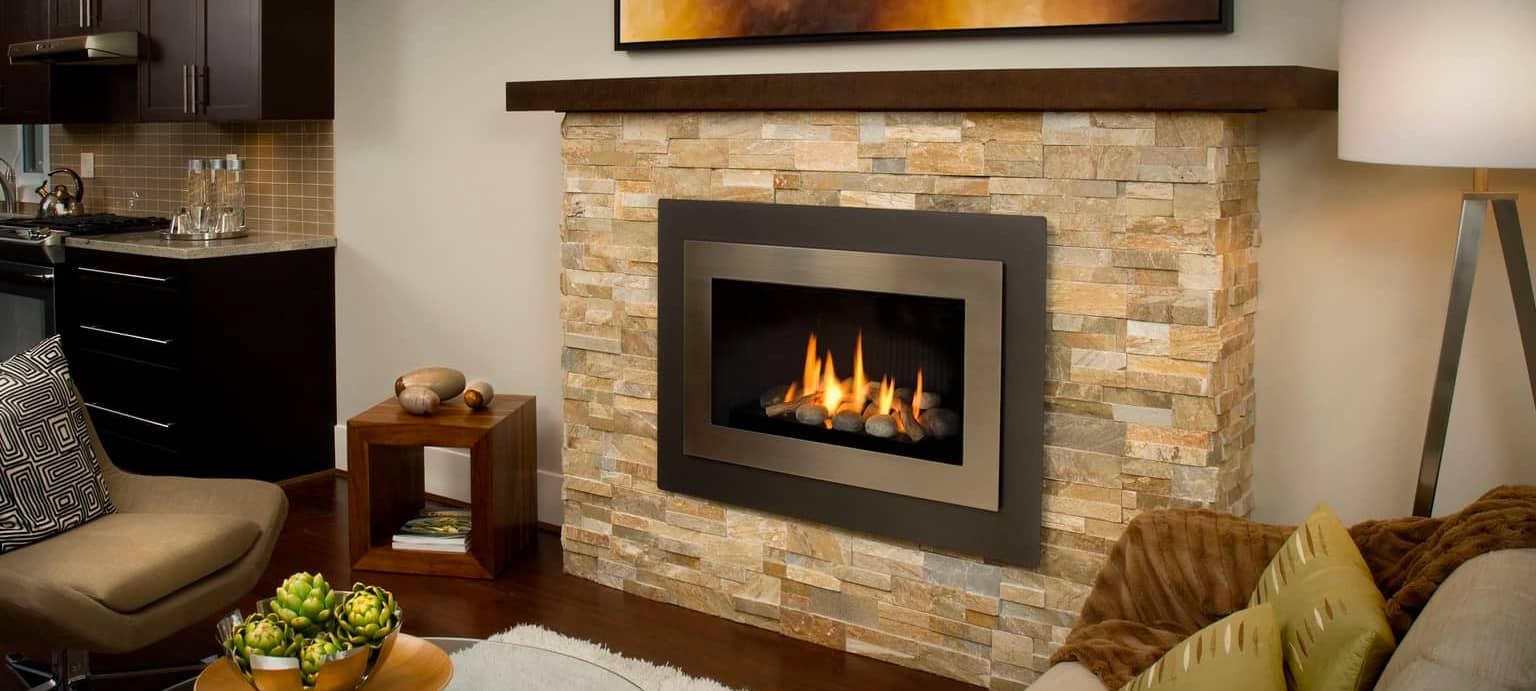
One of the standout features of many gas fireplace models is the ability to control and adjust the fireplace's settings with a simple click of a button, thanks to remote control technology. Understanding the basics of operating your gas fireplace, especially the use of remote controls, can enhance your overall experience, providing warmth and comfort with unparalleled ease.
Starting Up Your Gas Fireplace
Operating a gas fireplace begins with the ignition. While the specifics can vary between models, most contemporary gas fireplaces feature an easy-to-use ignition switch, often located near the fireplace's base or behind a panel. Some units come with a wall switch or even a remote app that allows for ignition. Ensure your gas valve is open and if your fireplace has a pilot light, check that it is lit before igniting the fireplace.
Using Gas Fireplace Remote Control
Remote Controls for gas fireplaces can vary in complexity, from simple on/off remotes to more advanced models that control everything from flame height and heat intensity to the color of the flames and the speed of the ember bed. Here's how you can typically operate your fireplace using a remote:
Powering Up The Gas Fireplace
Most remotes have a standard power button to turn the fireplace on or off. This button may be labeled with a power symbol or simply "on/off."
Temperature Control
If your remote is equipped with a thermostat feature, you can set a desired room temperature, and the fireplace will automatically adjust the heat output to maintain that setting.
Flame Adjustment
Some remotes allow you to modify the height or intensity of the flames, helping you create the perfect ambiance for any occasion.
Additional Features
Depending on your fireplace model, your remote may also control features like the blower speed and flame color or operate special effects like a crackling sound module. read our full instructions for our Valor 10, Plus and Max Remote Controls .
Remember, it's important to familiarize yourself with your specific fireplace model's remote control, as available features can vary widely. Always keep the remote out of reach of children or at-risk individuals.
Gas Fireplace Safety Considerations

Understanding and adhering to safety protocols is paramount to enjoying the comfort gas fireplaces provide. They are generally safe, efficient, and reliable, but like any appliance that involves heat and combustion, they require respect and diligence to maintain safety. Below, we delve into essential safety considerations every gas fireplace owner should follow. We have also compiled the essential gas fireplace safety tips if you want a detailed list of safety tips.
Installation by Qualified Professionals
The safety of your gas fireplace begins with its installation. It's crucial that a certified professional installs your fireplace to ensure it meets all safety codes and standards. Incorrect installation can lead to gas leaks, carbon monoxide poisoning, or fire hazards.
Ventilation and Carbon Monoxide Detectors
Proper ventilation is crucial for vented gas fireplaces. Ensure vents are not blocked or restricted to prevent the buildup of harmful gases. For all gas fireplaces, a working carbon monoxide detector is non-negotiable. This odorless gas can be deadly if not detected, and a functioning detector is your first line of defense.
Clear Space Around the Fireplace
Keep the area around your fireplace clear of flammable materials, including furniture, curtains, and home decor. A safe perimeter around your fireplace prevents accidental fires.
Follow Gas Fireplace Safety instructional Manual
Always follow the manufacturer's instructions for operating your gas fireplace. This includes how to ignite the fireplace, adjust the flames, and turn it off. If your fireplace uses a remote, keep it away from children.
Glass Window Can Be Hot
The glass panel of a gas fireplace can get extremely hot. It's a risk for burns, especially for young children and pets. Use a safety screen if your model doesn’t come with one, and always supervise children when the fireplace is in use.
Table of Contents
Gas Fireplace Installation Process
The installation process involves several critical considerations. It's not just about choosing a fireplace that matches your decor; factors like the location within your home, the type of gas fireplace, and ventilation requirements play crucial roles in the safety and functionality of your installation. Here, we'll explore what the installation process typically entails and why it's imperative to involve certified professionals every step of the way.
1. Pre-Installation Considerations
Before the actual installation, you'll need to make several key decisions:
- Gas Fireplace Location
- Type of Gas Fireplace
- Ventilation Requirements
- Gas Supply
Where will your fireplace be located? Consider the room's size, the presence of flammable materials, and where the fireplace will vent (for vented units). The location will also affect the gas line's routing (for natural gas fireplaces).
Are you opting for a vented, vent-free, or direct-vent model? Each has unique installation requirements. Vented models need to be placed where they can be connected to an outside vent or chimney, while vent-free models have more flexibility but may have restrictions based on local regulations. Before choosing a model, it's also important to ensure the fireplace’s physical dimensions are suitable for your space. Refer to our Gas Fireplace Dimensions Guide, for detailed sizing information, including width, height, depth, and viewing area.
For vented and direct-vent models, consider where the fireplace will vent. Is there an existing chimney or vent, or will one need to be installed? Proper ventilation is crucial for safety and performance.
Will you be using natural gas or propane? If your home already has a natural gas supply, it may dictate your choice. For propane, you'll need to consider the placement of the propane tank outside your home.
2. The Installation Process
Once you've made these decisions, the installation process can begin:
- Setting Up the Gas Supply
- Installing the Fireplace Unit
- Setting Up Ventilation
A certified professional should handle the gas line installation. This step involves running a line from your main gas supply (or propane tank) to your fireplace location.
This involves placing the fireplace in your chosen location, ensuring it's level and meets all clearance requirements. The venting system will also be installed at this stage for vented and direct-vent models.
For vented models, this could involve installing a new vent or chimney or adapting an existing one. Proper installation is crucial to ensure harmful gases are safely expelled from your home.
3. Final Touches
This includes installing any decorative elements, such as logs or stones, setting up the ignition system, and making final adjustments to the flame and gas flow.
Note - The Importance of Certified Professionals:
Gas fireplace installation involves working with gas lines and ventilation, complex tasks that carry potential risks if not done correctly. Certified professionals have the training and knowledge to handle these challenges, ensuring your fireplace is installed safely and up to code. They can also walk you through the operation of your new fireplace, ensuring you understand how to use it safely and efficiently.
Gas Fireplace Cost Implications
Investing in a gas fireplace involves various costs, from the initial purchase and installation to ongoing maintenance. However, beyond the expense, a gas fireplace can enhance the ambiance and comfort of your home, potentially increasing its overall value. Let's break down the costs you can expect and discuss the potential return on investment (ROI) a gas fireplace might offer.
Initial Purchase
The cost of the fireplace unit itself can vary widely depending on several factors:
- Type of Fireplace
- Features and Size
- Brand and Quality
Vented, vent-free, and direct-vent fireplaces can differ in price. Direct-vent models tend to be more expensive due to the technology involved, while vent-free models are often less costly.
Larger fireplaces with advanced features like adjustable flame controls, remote operation, or intricate designs will be more expensive than basic models.
High-end brands or models known for exceptional durability and performance typically command higher prices
Installation Costs
Installation can be a significant portion of your fireplace's overall cost, influenced by these factors:
- Gas Line Installation or Extension
- Venting Requirements
- Labour
If your home doesn't already have a gas line in the desired fireplace location, you'll need to factor in the cost of installing a new line or extending an existing one.
For vented and direct-vent models, you may need to install new venting or adapt existing structures, which can add to the cost.
Hiring certified professionals is crucial for safe and proper installation, and their fees will contribute to the overall cost.
Ongoing Maintenance
Regular maintenance is essential for the safe and efficient operation of your gas fireplace:
- Annual Inspections
- Part Replacements
Professional inspections are recommended annually and can involve fees for the service visit and any necessary repairs.
Over time, components like the blower, ignition system, or logs may need to be replaced.
Fuel Costs
Operating a gas fireplace will add to your monthly utility bills, though natural gas is often less expensive than electricity or heating oil.
Potential Return on Investment
Despite these costs, a gas fireplace can offer substantial ROI:
- Increased Home Value
- Energy Savings
Fireplaces are desirable features for many homebuyers, and having a modern, efficient gas fireplace can increase your home's appeal and potentially its resale value.
Especially in milder climates, using a gas fireplace for zone heating can reduce your overall heating bills by allowing you to lower the thermostat in the rest of your home.
Gas Fireplace Energy Efficiency and Environmental Impact

In our contemporary world, energy efficiency and environmental impact are critical considerations for any home appliance, and gas fireplaces are no exception. When we discuss the sustainability and eco-friendliness of these heating options, we need to consider their operational efficiency, the nature of their fuel source, and how they compare to other types of fireplaces and heating systems.
Direct-Vent Technology
Direct-vent gas fireplaces are particularly efficient because they draw in outside air for combustion, reducing the loss of heated indoor air. They also expel 100% of combustion gases outside the home, improving indoor air quality.
Zone Heating
Gas fireplaces effectively enable zone heating , where you heat only the rooms you're using. This approach can reduce overall energy consumption by allowing you to lower the thermostat in unoccupied areas.
Consistent Heat Supply
Unlike wood-burning fireplaces, which can fluctuate in temperature based on the wood's burn rate, gas fireplaces provide a consistent heat level, helping maintain energy efficiency throughout the operation.
Environmental Friendliness
When assessing environmental impact, gas fireplaces offer several advantages but also face some challenges:
- Cleaner Burning
- Reduced Carbon Footprint
- Consideration of Fossil Fuels
Natural gas is one of the cleanest burning fossil fuels. When used in an efficient gas fireplace, it produces fewer pollutants and particulates than wood-burning fireplaces, contributing to better air quality.
Efficient gas fireplaces can help reduce your home's carbon footprint, especially if they're replacing older, less efficient heating systems or wood-burning fireplaces.
It's important to acknowledge that natural gas is still a fossil fuel. While it burns cleaner than coal or oil, its extraction and use do contribute to greenhouse gas emissions. Homeowners concerned about their environmental impact might consider sourcing their energy from suppliers that integrate renewable energy sources or invest in carbon offsets.
Compared to Other Types
- Wood-Burning Fireplaces
- Electric Fireplaces
Traditional wood-burning fireplaces can contribute to deforestation and produce significant particulate emissions that affect air quality. In contrast, gas fireplaces don't involve burning wood and thus emit fewer particulates.

A downloadable PDF comparing Gas vs Wood Fireplace is available for a detailed comparison.
Electric fireplaces are considered environmentally friendly if the electricity comes from renewable sources. However, their efficiency can be lower than gas fireplaces, and if the electricity is generated from coal or gas, it can indirectly contribute to greenhouse gas emissions.
Gas Fireplace Regulations and Compliance
Installing and using a gas fireplace in your home isn't just a matter of personal choice and safety; it's also a matter of legal compliance. Various regulations govern the installation and operation of gas fireplaces, established by national standards, local building codes, and sometimes even homeowners' associations. These regulations are designed to ensure safe operation and prevent hazards such as fires, gas leaks, and indoor air pollution. Here, we'll discuss common regulations you might encounter and the importance of adhering to these standards.
National and International Standards
Several organizations set safety standards that apply to gas fireplaces, including:
This organization provides safety certification for products, including gas fireplaces. A UL-certified fireplace has been tested to meet specific safety standards.
The NFPA issues guidelines concerning fire safety, many of which apply to the installation and operation of fireplaces.
The ICC develops model codes for building construction and fire prevention that many local governments adopt.
- Underwriters Laboratories (UL)
- National Fire Protection Association (NFPA)
- International Code Council (ICC)
These standards cover various aspects of fireplace installation and operation, including ventilation, construction of the firebox and surrounding structure, and clearance from combustibles.
Local Building Codes
In addition to national standards, local building codes can dictate specific requirements for gas fireplaces. These might include:
Many localities require homeowners to obtain a permit before installing a gas fireplace.
After installation, a government inspector or a certified professional may need to examine the fireplace to ensure it complies with local codes.
Some areas have strict rules regarding venting for gas fireplaces, especially for vent-free models.
Regulations may dictate who can install gas lines (usually a licensed professional) and how they must be installed.
- Permits
- Installation Inspections
- Ventilation Requirements
- Gas Line Installation
Homeowners' Associations (HOAs)
If your community has an HOA, it might have its own rules regarding fireplace installation and use, especially concerning external structures like chimneys or vents.
Compliance with these regulations is crucial for several reasons:
First and foremost, these rules are designed to keep you and your community safe from fire hazards and air quality issues.
If a non-compliant fireplace installation leads to property damage or injury, it could result in legal consequences and voided home insurance claims.
When selling your home, non-compliance with regulations can lead to delays, decreased property value, or even the loss of a sale.
- Safety
- Legal Protection
- Resale Implications
Gas Fireplace Terminologies
For the most common gas fireplace terminologies please visit our dedicated page where we define the most common gas and electric fireplace industry terms.
In summary, gas fireplaces offer a perfect blend of modern efficiency and traditional comfort. They are a convenient, low-maintenance alternative to wood-burning fireplaces, providing consistent heat and enhancing the aesthetic appeal of any home. With various models like direct-vent, vent-free, and inserts available, they cater to diverse needs and preferences.
These fireplaces are energy-efficient, cost-effective, and environmentally friendlier compared to traditional fireplaces. However, proper installation, adherence to safety standards, and regular maintenance are crucial for their optimal functioning.
